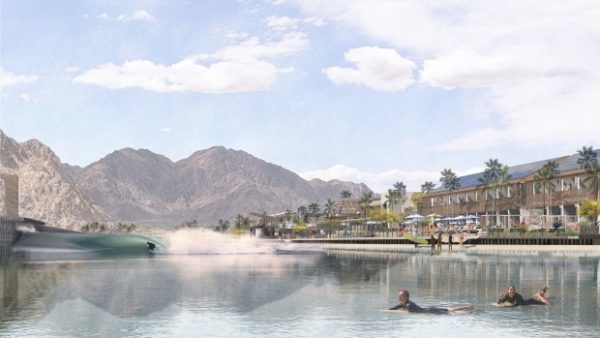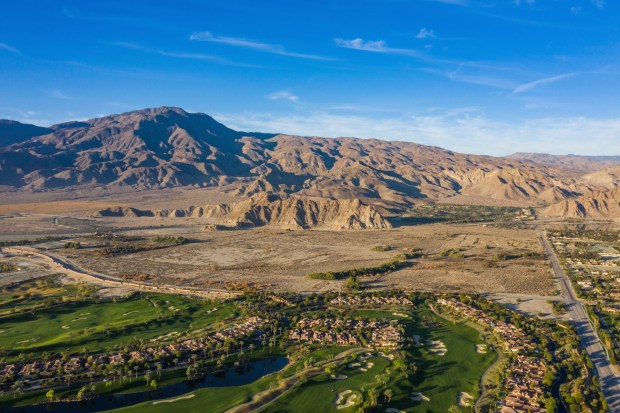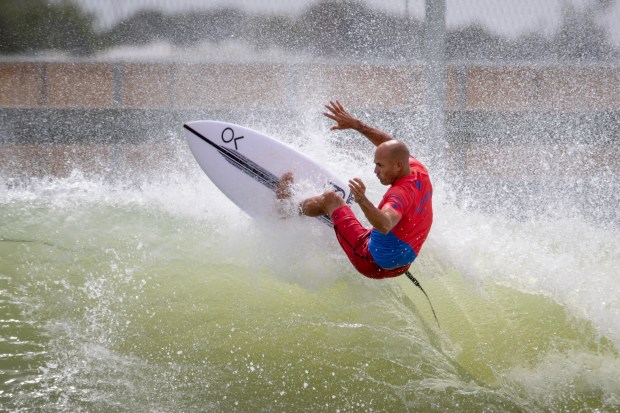
The dry desert, not far from Southern California’s popular beaches, could become the newest hot spot to catch waves — with four wave pool projects in the works.
But will concepts by pro surfers and investors to bring surfing inland be a wipeout? Or will they draw new tourists seeking surf time away from the ocean?
Plans were released this week for a new wave-pool development called Coral Mountain, a full-service resort with residential homes, a private club, restaurants and “progression-based training for the mind, body and soul,” in La Quinta. It will use technology created by 11-time surf champ Kelly Slater, reads an announcement of the project.
The news comes as another wave pool, DSRT Surf, planned nearby by a handful of other pro surfers and investors, continues on course to bring man-made waves to the area by 2021. Other projects in Palm Springs and nearby Thermal are being discussed, in hopes of getting a piece of the wave-pool action.
Building artificial waves — and constructing resort areas with luxury real estate developments surrounding those waves — could change the landscape of the region, already a popular destination for fans of music festivals, golf and poolside relaxation.
Coral Mountain would use Kelly Slater Wave Company technology, though it’s unclear if it’s the same used at Slater’s Surf Ranch wave pool in Lemoore, set in the agricultural center of the state.
The Surf Ranch, so far has been accessible only to surfing’s elite, industry insiders and people willing to spend big bucks to surf the barreling waves meant for advanced riders. The new development would be quasi-private, with access “exclusively available to homeowners, hotel patrons, members and their guests, and dining available to the public through reservations,” the announcement reads.
Coral Mountain calls for 600 residential units, a 150-room hotel and 60,000 square feet of commercial space, as well as a community garden, and recreational uses such as golf practice facilities, trails and tennis, according to the city of La Quinta.
An 18 million-gallon wave pool basin would hold about 25 surfers — five on the main wave and 10 on each of two smaller waves at the ends of the basin, with waves for all levels of ability.
The Kelly Slater Wave Company is owned by the World Surf League and for this project will partner with real estate investment firm Meriwether Companies and Big Sky Wave Developments, founded by Michael B. Schwab, son of brokerage pioneer Charles Schwab.
Plans still must go through the city approval and environmental study process, but if the project gets the go-ahead, the 12-acre wave pool would be built west of the Andalusia Country Club development, according to city planners. Construction would begin in the first quarter of 2021.

Mimicking the ocean is no new concept, with attempts going as far back as the ’80s. But wave technology wasn’t ready decades ago — they were more novelty attractions rather than waves surfers would be stoked on.
As technology has improved, wave pools have been built around the world, including BSR wave pool in Waco, Texas. Slater originally had plans for a public wave pool in his hometown of Florida, but that proposal sank after it was found it would negatively affect the area’s high water table.
Danny Castro, design and development director for the city of La Quinta, said staff is reviewing the Coral Mountain proposal.
“It’s something that is new, obviously. It’s not a golf course,” Castro said. “This new technology is something I think people are excited about. … This is a different aspect and type of wellness activity that just makes us much more diverse in terms of attracting people to La Quinta.”
The Slater pool is just the latest in what could shape up to be a wave-pool rivalry. DSRT SURF, in nearby Palm Desert, already has gained city approval.
“Those of us who are putting this together, we are lifelong surfers. We’re transposing what we do on the coast to this inland location,” Marco Gonzalez, a partner and attorney with DSRT SURF who grew up surfing Oceanside, said in a past interview.
The project is set on 17 acres within the Desert Willow Golf Resort. Cost for the DSRT SURF land is an estimated $2.5 million, with the total project build-out expected to be about $200 million.

The surf lagoon will be on 5.5 acres and a “surf center” will have ticketing, restaurants, a bar and retail shops. A hotel — with up to 350 rooms — and 88 residential villas will occupy about 5.84 acres. The pool, to be open to the public, would hold 60 to 80 people in the water at any given time, with waves that can be programmed for different skill levels, spread between five or six different peaks.
Gonzalez and partners Doug Sheres and John Luff teamed up with pro surfers including brothers CJ and Damien Hobgood, from Florida, Australian Josh Kerr and Hawaiian Shane Beschen for the project.
Sign up for our Coast Lines newsletter, a weekly digest of news and features on how the residents of the SoCal coast are building ties to their changing environment. Subscribe here.
“We all understand the desert is probably the best place to locate a man-made wave, given the year-round good weather out there,” Gonzalez said Thursday, Feb. 27. “If the valley becomes a destination for people wanting to ride man-made waves, that’s good for everybody.”
Gonzalez and other investors have created the Beach Street Development company, which holds the licenses for Wavegarden Cove technology in Southern California, Las Vegas, Austin, and the D.C. area, the same machines that will power DSRT Surf.
Another project, the Thermal Beach Club about 25 miles from Palm Springs, will have a 20-acre clear blue lagoon surrounded by villas, with waves powered by American Wave Machines PerfectSwell technology. There will be more than 325 units on 210 resident lots, bungalows, villas and estates; a 16,000-square-foot recreational center with a spa and exercise room; an 8,000-square-foot pool and bar; and a 4,500-square-foot clubhouse restaurant with bar.
Another plan, the Palm Springs Surf Club, is a $50 million development with a 21-acre wave pool at the old Wet ‘n Wild site, according to surf publication The Inertia. The property was purchased by surfers Cheyne Magnusson and Kalani Robb.
Already, surfers in the region are stoked. The Coachella Valley Surf Club was started recently by Dave Hilts, a longtime surfer originally from Huntington Beach who travels from his desert home to surf in Oceanside.
Fellow surfers give him a hard time about living in the desert, he said. “All of a sudden, it’s going to become a surfing community,” Hilts said with a chuckle.
Hilts said he started the nonprofit club with the goal of getting area youth involved in the sport.
“A lot of the kids have never been to the beach,” he said his teacher wife told him. “It just kind of struck a chord with me.”
Hilts took a few members of the Desert Mirage High School surf club to Oceanside recently to teach them to surf and said he hopes wave-pool developers will offer scholarships and events for future wave-pool surfers.
“I’m ecstatic. It’s just unreal. It’s really neat they’re coming here,” said Hilts, who in the ’70s was on the first Huntington Beach High School surf team. “It’s a completely new chapter of surfing.”

Bringing wave pools to the region – as well as the real estate surrounding the pools – could make the area more attractive for investors. But there’s the other side cities such as La Quinta must consider, Castro said, such as the impact to residents.
“Like any development proposal, there’s also the other side of people who probably wouldn’t want something like this,” he said. “While there’s many good things, it’s about achieving a balance, there’s still quality of life. Residents have chosen to live here for tranquility and peace. The question becomes, how much will that impact them? As our city reviews the proposal, we have to look at those things to achieve a balance.”
There’s also the question of whether surfers – who have access to the ocean for free – will pay money to ride waves. So far, none of the projects have hinted at the fee.
Louis Rice, a Huntington Beach surfer, said he’d be willing to try a wave pool if the price was reasonable, such as at BSR, where prices range from $60 to $90 an hour.
“But for now, it remains the exclusive realm of those willing to pay exorbitant fees to surf,” Rice said, “which is antithetical to what surfers are and do.”
The Associated Press contributed to this story.





Recent Comments